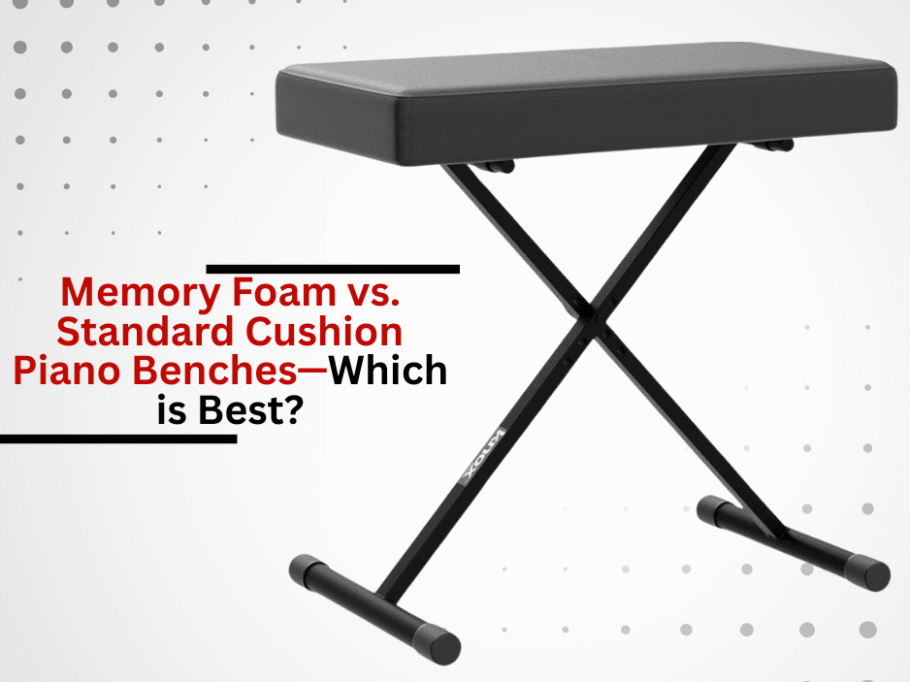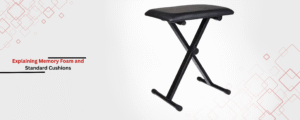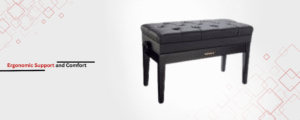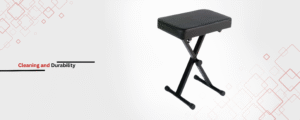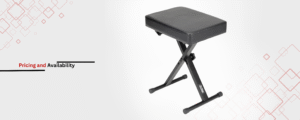Whether you prefer a memory foam piano bench or a standard cushion one, your preferences should align with the level of comfort, durability, and your playing style. The cushion type – padded vs. firm piano seat – raises relevance as musicians focus more on ergonomic comfort during long practice sessions. In this article, we’ll review both options that are analyzed to explain their pros and cons in order to make better decisions.
To know more, read: How to Build Your Own DIY Keyboard Bench
Explaining Memory Foam and Standard Cushions
What Is A Memory Foam Piano Bench?
Known as a viscoelastic material, memory foam is a knee-to-chin-thick material that hugs the shape of the body. They say you can spindle memory foam without putting your weight on it initially, which reduces pressure. Praise is given to memory foam piano benches because they provide supportive backrests and thighs for their users with adaptive support to strengthen backs and hips.
What Is A Standard Cushion Piano Bench?
Standard cushion benches are constructed using various materials such as high-density foam, polyester fiberfill or coiled springs. These benches prioritize firmer cushions because of the focus placed on reliable support and versatility for the user. It can easily lower costs while being cheaper than memory foam versions.
Evaluating Comfort and Ergonomic Support
Pressure Relief and Posture Support:
Memory foam cushioning in seats is best for reducing damage to the tailbone and thighs during long sits. It is more beneficial than firmer surfaces, cutting muscle fatigue by 20–30%. It is important to note, however, that some users “sink” into the surface, and this may make dynamic playing movements more difficult. Standard cushions are best for classical piano seating since they provide consistent support and allow the performer to retain classical alignment since the seat position is fixed and supported. Classical pianists prefer firm cushions, as they allow for an upright position; however, it may lead to discomfort after 1 to 2 hours of continuous use.
Temperature Control:
The high temperature of one’s body can be an issue while using memory foam, especially in warm settings. Some Open cell and Gel infused options offer this solution, although they come at an additional price. Standard cushions, especially those made from mesh and cotton, are more breathable and remain cooler over time.
Cleaning and Durability
Material Lifespan:
Cushions utilizing memory foam can be expected to sag routinely after 3-5 years due to constant compression. Added weight and reduced lifespan are caused by using stiffer foams like 2.5 lbs. per foot. Rotating the cushion periodically can delay wear.
Standard cushions using high-resilience HR foam or spring cores are more durable, maintaining optimal shape for an average of 5-8 years, while their Lo-Fi filler models may collapse within 1-2 years.
Cleaning and Maintenance:
Memory Foam: Must have machine-washable, removable covers to mitigate sweat, dust, and general filth accumulation. Blotting any form of spill immediately is a must to prevent any kind of absorption.
Standard Cushions: Stain-resistant upholstery is commonplace (vinyl or polyester) and can be cleaned with a simple wipe. Fill fiber cushions need regular airing to prevent odor accumulation.
Pricing and Availability
Pricing:
- Memory foam benches range from $120 to $300 based on brand and foam density.
- Standard cushion benches go from $60 to $180, with those containing coiled springs at the higher end.
Need this in bulk? You can get this from wholesale – piano bench
If you need this at the best prices, you might check out this new platform – piano bench
Weight and Portability:
Due to denser materials, memory foam benches are usually 20-30% heavier, which makes transportation more difficult. Standard cushions, and particularly portable ones with foldable frames, are ideal for gigging musicians.
Recommended Use Cases
When to Choose a Memory Foam Piano Bench:
- For practice sessions lasting 2 hours or more.
- Having a prior medical history of back or hip pain.
- Static studio environments where the bench isn’t moved often.
When to Choose a Standard Cushion Piano Bench:
- Need to perform with dynamic posture changes.
- Restrictions in budget or need for lightweight gear.
- Preference for a more responsive and firmer seat.
Hybrid Options and Enhancements
Aftermarket Cushion Toppers:
Add on optional A memory foam topper can be added to a standard bench for 30-80, which fuses comfort with the preexisting structure. This does, however, increase the height of the seat, which might need the adjustment of the bench in relation to the piano.
Adjustable Firmness Models:
Premium benches now feature dual-layer cushions, with removable inserts, which allow users to toggle between padded and firm support. These hybrids meet varying needs but cost 200–400.
Expert Opinions And User Feedback
In 2024, a survey conducted on 500 musicians showed the following results:
- 62% prefer memory foam while practicing at home.
- 78% chose standard cushions during live performances.
- 45% pointed out heat retention as their main complaint regarding memory foam.
Conclusions
The prioritization of characteristics will determine the best cushion type for each individual piano player’s needs: memory foam excels in ergonomic support for prolonged use, while standard cushions remain practical and affordable. The battle over padded vs. firm in the case of a piano seat rests, primarily, on the interplay of comfort, durability, and ease of movement. One can select from a wide variety of brands like On Stage, 5 Core, Roland, and Donner, which all offer solutions to every pianist’s requirement. By pairing these features with the right playing style and the pianist’s physical needs, comfort and performance can be maximized.

